Amaranth annual herbaceous plant, from ancient times famous for its miraculous power, capable of prolonging life, a protein pantry that surpasses all cereals, giving saturation and at the same time lightness. “Shiritsa” or “Cockscomb”, as it is also called in Russia, also has decorative forms, its never-fading inflorescences, brightly colored leaves will decorate any landscape with the poorest soils, without requiring special treatment.
Material Content:
Amaranth - description of a plant from the amaranth family
Amaranth plant, translated from Greek means "unfading flower", whose homeland is South America, is thermophilic. Shiritsa has strong, developed roots that can penetrate deep into soil waters, saturated with moisture and nutrients.

Thanks to the root system, a powerful juicy stem grows (depending on the species) up to 2 m, is able to gain green mass from 3 to 30 kg, can be simple or branched.
The rich leaf mass consists of large, juicy ovoid, lanceolate, rhomboid leaves on long cuttings, located alternately. The color is different, also relative to the type: green, yellow, purple, crimson or three-colored.
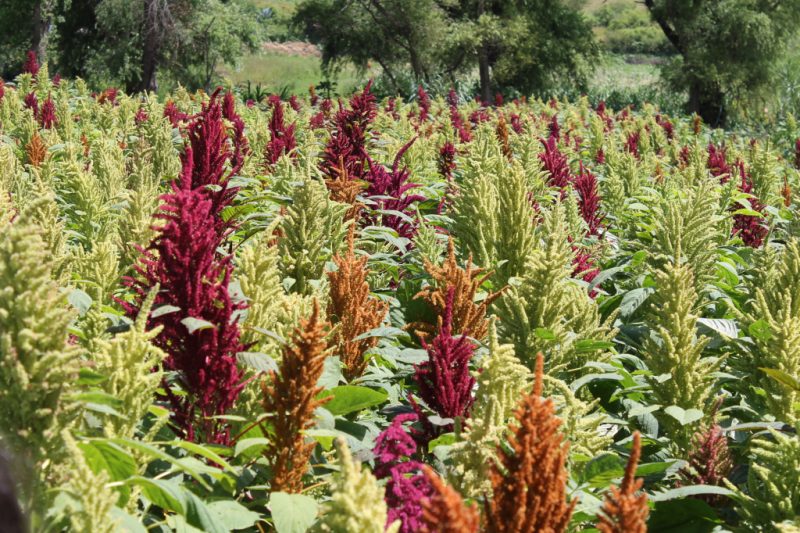
The flowers are small, collected in complex spike-shaped inflorescences, straight or drooping. Flowering occurs over 8 weeks.
Amaranth fruit - a box with small, like grains of sand, seeds, up to 2000 pieces. Seeds have a different color: edible varieties - light, decorative - dark, germinate up to 5 years.
Where grows in Russia
Plants from the amaranth family have drought tolerance and withstand salinization of soils. Due to this property, wild species are widespread throughout Russia, having reached us in the 19th century, amaranth was immediately assigned to the category of malicious weeds.
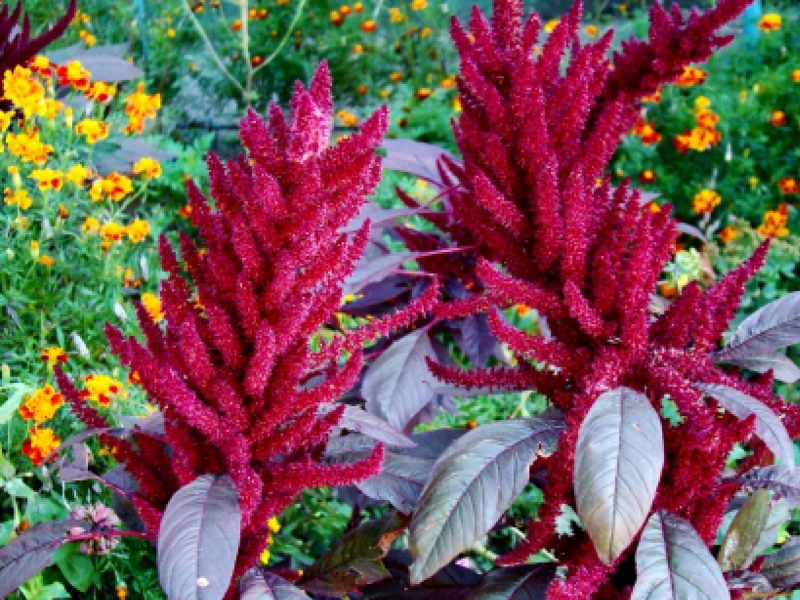
All in all, about 15 species grow in our country, the most common is Amaranth thrown up (common shiritsa), which serves as an excellent livestock feed, growing in the fields, along roadsides, at the same time littering gardens and vegetable gardens.
Despite the difficulties of growing young shoots of cultivated grain varieties, many agronomist enthusiasts take up the cultivation of this crop and achieve success, as evidenced by the emerging products from flour and grain.
Amaranth grain is grown in the Southern Urals, the Middle Volga in the southern regions (varieties: Helios, Kharkovsky 1, Voronezh, Ultra). Voronezh has the largest amaranth oil production plant in Russia.
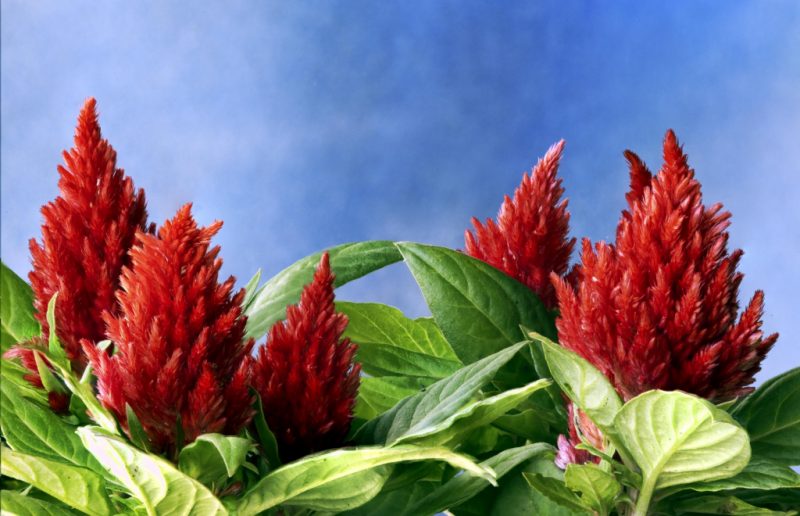
In large farms of Tatarstan, green grass is used to produce high-quality grass flour and granules with a protein content of up to 20% for poultry farms (varieties: Giant, Emperor, Aztec).
On garden plots gardeners grow decorative and mixed species, characterized by unpretentious growth and extraordinary aesthetics.
Types and varieties of amaranth plants
The genus of amaranth is about 60 species that differ in purpose and characteristics, including wild weeds common around the world.

Of particular importance are the oldest crops valued for healing and nutritional properties and grown as crops in a warm climate, mainly in Mexico, India, China. Their grains are used in food by both humans and animals for the manufacture of oils with unique healing properties and a cosmetic effect that smooths scars and protects the skin from ultraviolet radiation (Amaranthus cruentus, Amaranthus caudatus).
There are species in which all the aboveground parts are edible (young leaves resemble the taste of spinach).
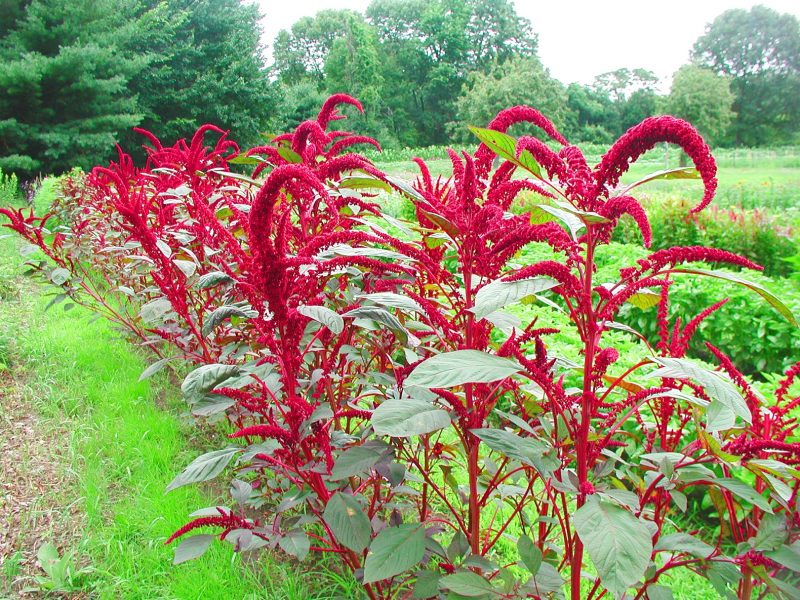
Cultivated as vegetable plants used in cooking, especially in East Asian countries, which are successfully grown by our vegetable growers in personal plots bred by Russian breeders:
- Fortress - early ripening variety, ripening occurs already 80 days after seed emergence. Bushes grow up to 140 cm with juicy green leaves that contain 14-15% protein, and erect large long spikelets of brownish flowers;
- White list - dwarf variety, allows cultivation at home, as it has a stalk height of up to 20 cm, leaves and stems are painted in light green color;
- Valentine - the first most popular variety and the only officially recognized vegetable culture, mid-season, 3.5 months pass before full maturity, leaf maturity can be judged by the red-violet color, which begins to appear after 45 days and can already be consumed.
All parts of the plant are edible, they are added to salads, they prepare drinks, fermented, pickled, dried, and all vitamins and minerals are preserved. There are many other universal varieties used for livestock feed, and the leaves of which serve as a good complement to hot dishes, for example, Opopeo, Oscar Blanco, Kizlyarets, Red Vietnamese - have a tart taste.
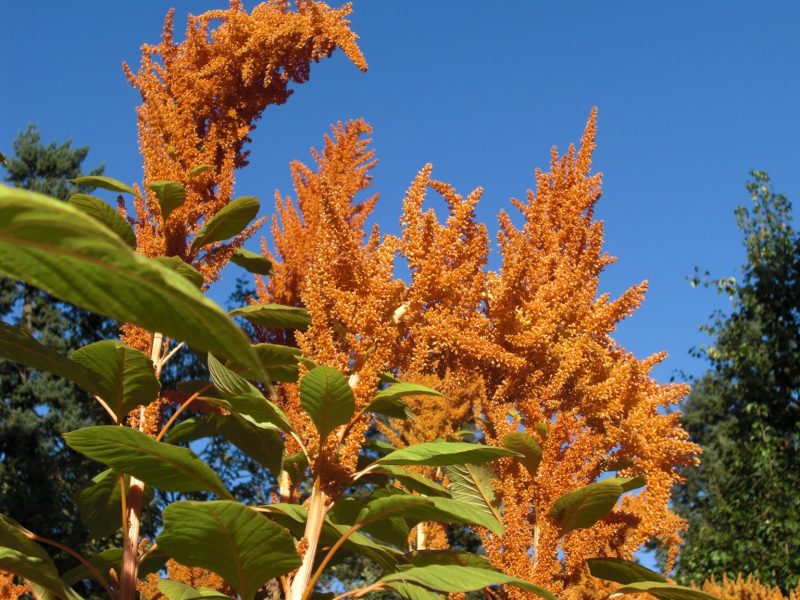
Of the decorative plants in Russia, only 4 species of amaranth are grown, including numerous varieties that differ in shape and color.
- Amaranth is tailed. The most popular type. A distinctive feature is the extraordinary beauty of the long flowing brushes of inflorescences, formed from small flowers that are tightly adjacent to each other, burgundy, red, raspberry, green and white. The stalk is powerful, 40 to 150 cm tall, erect with large, elongated, juicy leaves.Varieties: Rothschwanz, Mace, Athlete, Green Icicle, Raspberry beads, Avalanche.
- Tricolor. It is unique in its unusual different colors and leaf shapes, present on one stem. For example, some varieties have long upper pinnate leaves of yellow or raspberry color with a wavy edge and dark green or dark purple lower; with red, yellow interspersed oval with a pointed tip; others are of the same egg-shaped leaf plate, combining green-yellow-red shades. Upright shoots form pyramidal bushes 70-150 cm high. The flowers resemble small panicles and bloom until late autumn (Illumination, Aurora, Airlie Splender, Brazilian Carnival).
- Panicled or crimson. This species is notable for the presence of low-growing (dwarf) varieties up to 20-30 cm, medium-sized bushes up to 60 cm and tall up to 100 cm. The stem is strong, upright. Leaves are painted in dark maroon color. The inflorescence is an upright panicle of purple color, there are varieties with drooping ears. Popular varieties: Rother Dam, Grünfakel, Hot Biscuit.
- Dark. It differs in mixed green with purple veins color of leaves, pointed at the end, which gives a dark shade. A branched medium-sized bush from 40-60 cm tall, spike blossoms with similar vertical inflorescences of brown and bright red color (Pygmy Torch, Green Tamb).
Decorative amaranth grain is not recommended, but leaves can be added to summer salads. Dried inflorescences are used in winter bouquets and flower arrangements.
Growing Features
The photophilous, thermophilic amaranth plant grows on any soil, including rocky and salt marshes, except for marshy, swimming clay and loamy soils.
Features of cultivation depend on the purpose of the plant and the climatic conditions of the region. The culture tolerates summer drought well, quickly recovering from watering.
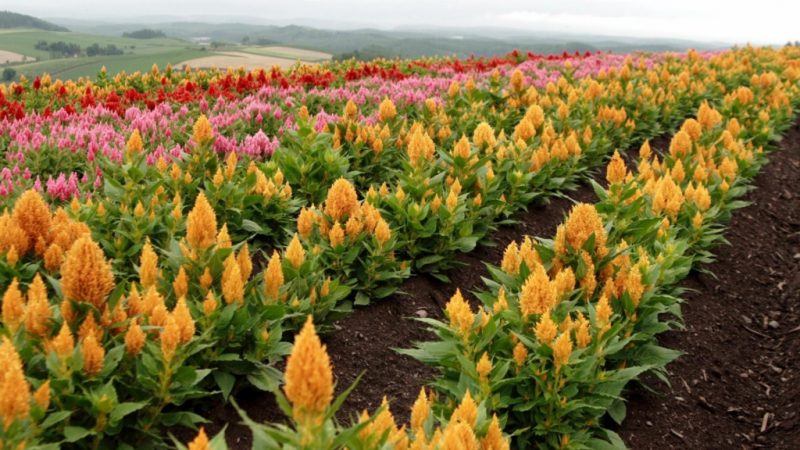
Regions with a warm climate and low rainfall, and dry autumn are more suitable for obtaining grain. For green mass and decorative varieties of amaranth, warm sunny summers with regular rains are most favorable.
Particular attention is paid to the depth of seeding during sowing, it should not exceed 1 cm, in the field - 1.5 cm.
The duration of the germination period depends on external and soil temperatures. Germination occurs at soil temperature + 8 + 100.
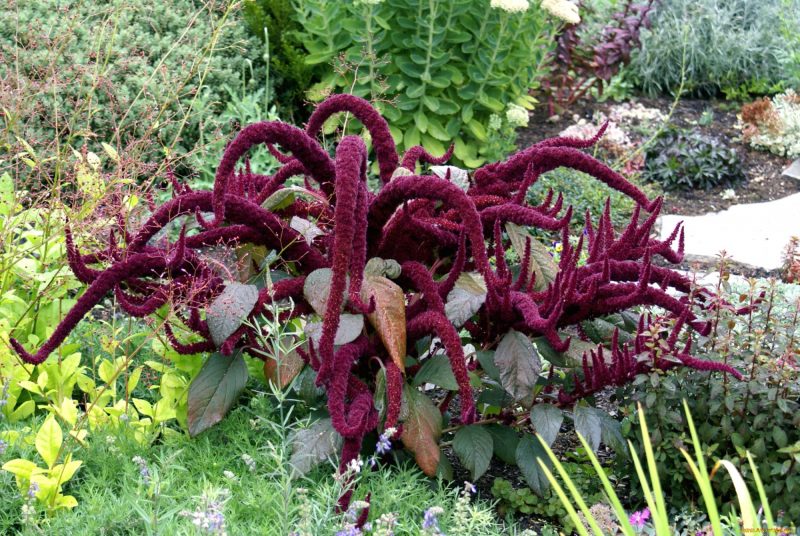
Shoots are small, need a lot of light, so the soil should be without weeds. The first 3 weeks they are regularly removed.
Amaranth is responsive to feeding, being a crop that needs a high level of readily available nutrients, it involves soil preparation in the fall, with the introduction of complex fertilizers or planting after the precursors under which compost was applied, then nitrogen fertilizer during the growing season is enough.
The dose of nitrogen also depends on the task of growing: to obtain grain, they are reduced by half from the required instructions, this inhibits the growth of the plant, accelerating the ripening of seeds.
The terms of assembly of amaranth depend on its further use, usually it is 90 - 130 days. On large farms, shiritsa is harvested in combines, in the household, greens and panicles with grain are manually cut.
Outdoor grass planting
In cool areas with a short summer period, decorative species are grown by seedlings. For the sake of medicinal leaves or in warm areas, seeds are sown immediately in open ground.
Seeding for seedlings produced in early March, given the long term germination of seeds. Sown as ordinary small seeds (mixed with sand) in grooves or over the entire surface of moist soil, with further thinning. Sprinkle with a thin layer of earth, moisten with a spray bottle. Cover with glass, clean in a warm place for germination. Care consists in daily airing. Within 14 days, seed germination occurs.Once the seeds have sprouted, they must be transferred to the light.
Thinning It is made for selection of strong, viable seedlings, as soon as you can grab onto them with your hand, leaving a distance between shoots of 2-3 cm. It is necessary to moisten the sprouts as the top soil layer dries. Amaranth is drought tolerant, but it is sensitive to excess water. It is only necessary to maintain the earth from drying out.
Pick grown seedlings are made after the appearance of 2 true leaves (not including cotyledon). Amaranth tolerates transplantation well, so there are no special requirements, dive into individual pots. Care like any other seedlings, preventing waterlogging of the soil, not forgetting to loosen it.
Amaranth landing in open ground occurs when the soil warms up to + 150, and return frosts pass. In a soil pre-fertilized with nitrogen, holes are made at a distance of 30 cm from each other. Sprouts are planted together with a lump of earth, the soil around is well compacted, watered.
How to care for amaranth
Unpretentious amaranth in the phase of initial growth is a delicate, vulnerable plant.
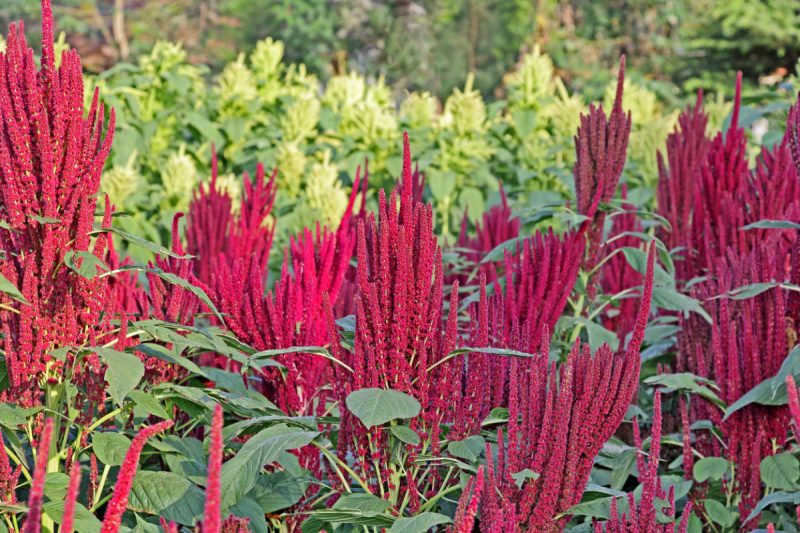
During this period, it is necessary to pay more attention to it:
- remove weeds in a timely manner;
- water, as the soil dries;
- loosen the soil crust.
Usually, sprouts need the first month of growth. The rest of the time, it is only necessary to fertilize and water during a period of prolonged drought, as a rooted plant takes moisture and food from the deep layers of the earth.
Top dressing after rain or watering in the morning or evening hours. You can use ash (200 g per 10 liters of water) or a solution of manure (1: 5).
Disease and Pest Prevention
Diseases and pests practically do not threaten an adult plant, with the exception of fungal diseases that can occur in a very rainy summer. With excess moisture, various rot may develop, plants are treated with fungicides: copper sulfate, colloidal sulfur and other similar means.
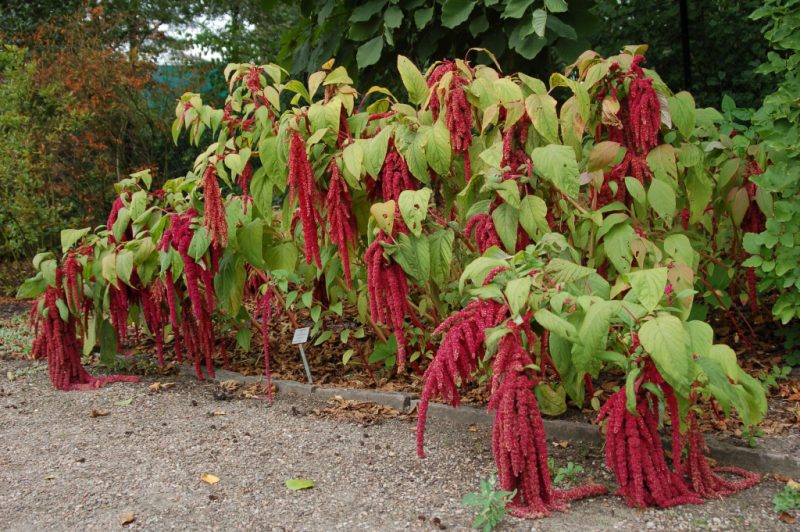
Young seedlings, like many garden plants, are invaded by aphids and weevils. Spraying with fufanon, actelik and other insecticides of amaranths and all garden neighbors will also help here.
An important preventive action is weeding and loosening the soil.
The benefits and harms of plants

Unconditional, scientifically proven, the benefits of amaranth for the body in its chemical composition.
- A high content of amino acids, 77% of which is non-synthesized lysine, which is part of the protein: a builder of muscles, collagen and immunity, which contributes to the accumulation of serotonin (a hormone of joy), has a positive effect on vision, hair growth, and slows down aging.
- Essential omega-3 and omega-6 fatty acids are included.
- Vitamin E and its derivative tocopherol are powerful antioxidants that improve blood circulation, cleanse blood vessels, and rejuvenate cells.
- Macro and trace elements: potassium, magnesium, phosphorus, calcium, copper, sodium, zinc, iron, manganese.
- Svalen is a polyunsaturated hydrocarbon that supplies cells with oxygen. It is one of the main components of the skin that fights cancer cells.
- Phospholipids restoring affected cells.
- Vitamins of group B, D, PP, C, necessary for the functioning of the body.
Amaranth is believed to be able to cleanse the body of heavy metals and toxins. Used for the treatment of respiratory, genitourinary system, liver diseases. These and many other properties make the plant unique.
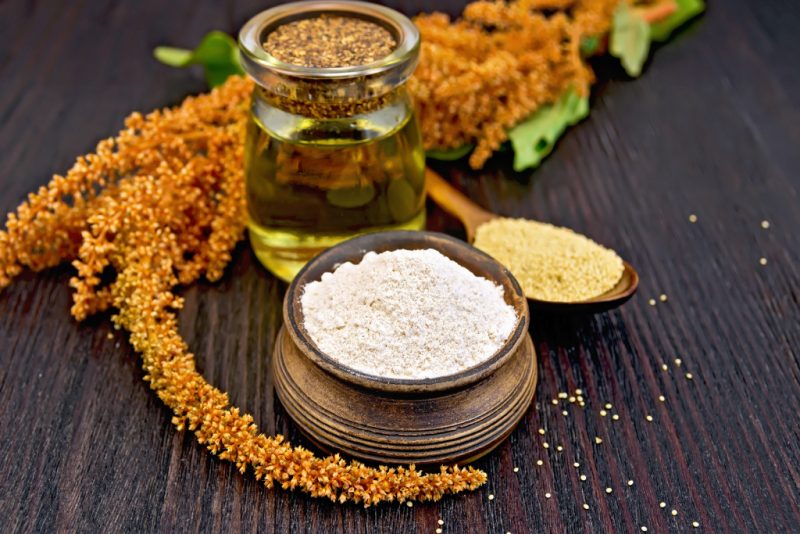
It is important that the nutritional and healing properties are preserved during processing, this allows the plant to be used in cooking and preparing decoctions, oils, tinctures.
Amaranth is widely used in cosmetology for the preparation of creams, masks, baths, restoring skin elasticity. Regenerating epidermal cells, promotes wound healing, smoothing scars.
Contraindications for the use of amaranth products: individual intolerance, chronic gastrointestinal diseases in the acute stage, with caution - pancreatitis, cholelithiasis and urolithiasis.
Growing amaranth in your area, you can combine aesthetic pleasure with the use of healthy leaves.












